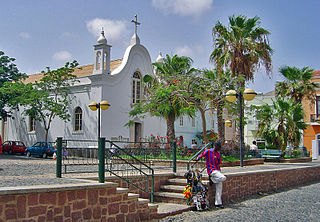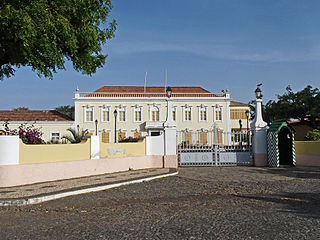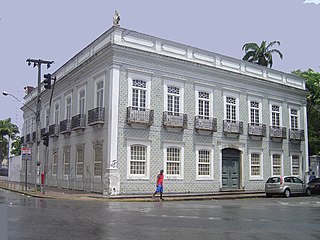
Mindelo is a port city in the northern part of the island of São Vicente in Cape Verde. Mindelo is also the seat of the parish of Nossa Senhora da Luz, and the municipality of São Vicente. The city is home to 93% of the entire island's population. Mindelo is known for its colourful and animated carnival celebrations, with roots in Portuguese traditions.

Fogo is an island in the Sotavento group of Cape Verde. Its population is 35,837 (2015), with an area of 476 km². It reaches the highest altitude of all the islands in Cape Verde, rising to 2,829 metres above sea level at the summit of its active volcano, Pico do Fogo.

São Filipe is a concelho (municipality) of Cape Verde. Situated in the western part of the island of Fogo, it covers 49% of the island area, and is home to 60% of its population. Its seat is the city São Filipe. Agriculture is the main employment of the municipality, followed by tourism.

Espargos is the capital and main commercial centre of the island and municipality of Sal, Cape Verde. The city is situated in the heart of the island.

Nova Sintra is a city in the central part of the island of Brava in southwestern Cape Verde. It serves as the seat of the Brava Municipality. The settlement is named after Sintra, the summer residence of the Portuguese kings. Its population is about 1,500. Its elevation is around 500 meters. Since 2010, Nova Sintra has been a city. Agriculture is the predominant source of income on Brava. Tourism is less developed, but there are a few small hotels and guest houses. The "aluguer" buses to the other villages start from Praça Eugénio Tavares.

Furna is a seaside community in the northeastern part of the island of Brava, Cape Verde. It lies 2.5 km northeast of the island capital of Nova Sintra. At the 2010 census its population was 612.

Fajã de Agua is a village on the northwestern coast of the island of Brava, Cape Verde. It is 4 km west of the island capital Nova Sintra. Fishing and agriculture are the most important sources of income.

São Jorge is a settlement in the northern part of the island of Fogo, Cape Verde. It is situated near the coast, 2 km west of Campanas Baixo, 2 km northeast of Galinheiro and 15 km northeast of the island capital São Filipe.

Salto is a settlement in the southern part of the island of Fogo, Cape Verde. It is situated 2 km (1.2 mi) southwest of Monte Largo and12 km (7.5 mi) southeast of the island capital São Filipe. The village has a sightworthy church and some small shops, but no accommodation for tourists. Most of the inhabitants are farmers growing potatoes, vegetables and papayas. Several fields are irrigated using drip irrigation. Many fields were surrounded by stone walls to protect them against erosion.

Ponta Verde is a town in the northwestern part of the island of Fogo, Cape Verde. In 2010 its population was 1,072. It is situated 11 km northeast of the island capital São Filipe.

Henrique Teixeira de Sousa was a doctor and author from Cape Verde.

Mosteiros is a city in the northeastern part of the island of Fogo, Cape Verde. It is situated on the coast, 24 km northeast of the island capital São Filipe. It is the seat of the Mosteiros Municipality and of the civil parish Nossa Senhora da Ajuda. At the 2010 census its population was 4,124, making it the island's second most populated place.

Cape Verde was a colony of the Portuguese Empire from the initial settlement of the Cape Verde Islands in 1462 until the independence of Cape Verde in 1975.

The Pro-Cathedral of Our Lady of the Light is a Roman Catholic church in the city of Mindelo, on the island of São Vicente, Cape Verde. It is located on Rua da Luz, in the city centre. Built in 1862, it is one of the oldest buildings of Mindelo. However, the church has been enlarged recently, leaving only the façade in its original state. It is the seat of the Roman Catholic Diocese of Mindelo, created in 2003.

Museu Municipal de São Filipe is a museum located in the historic centre of São Filipe, on the island of Fogo, Cape Verde. It is located in a sobrado, a colonial town house. The museum was opened on December 13, 2008, by the town president Eugênio Miranda da Veiga.

Estádio 5 de Julho is a multi-purpose stadium in São Filipe, Cape Verde just east of the city center known as Bila Baxo and is near Alto da Aguadinha. It is currently used mostly for football matches. The stadium holds 1,000 people. The stadium is named with the date of Cape Verdean independence.

The Architecture of Cape Verde has different architectural styles in the nation. Unlike the African mainland, Cape Verde was uninhabited until 1461 when the Portuguese arrived, most of the other islands were first inhabited after the end of the 15th century. Its architecture was introduced in the 1460s and has its first origins from Portuguese settlers from the Madeira Islands, after the first arrival of mainland Africans, a bit of African architecture would be elements mainly in rural areas. The Manueline was its first architectural style on the island, it was later followed by Renaissance, Baroque, Pombaline, Early Modern and Modern. It was one of the last in the whole of Africa to introduce architecture late. Cape Verde has one of the richest architecture in the western portion of West Africa, the sub-Saharan portion, the richest probably being Mali.

Funco is a traditional Capeverdean house that originated from Africa. Its houses are mainly founded on the islands of Fogo, Santiago and Maio, it is represented in Guinea-Bissau. Its circular form are made of different kinds of rock. The conical roof is made up thatch of palm leaves and has only a piece.































